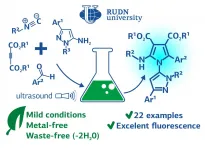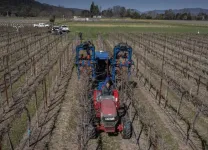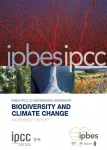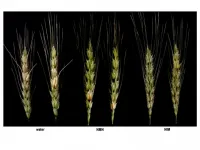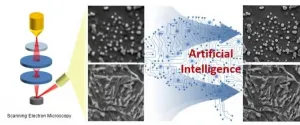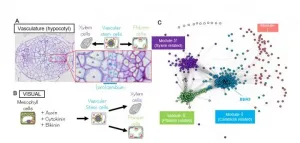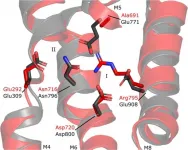New way to 3D-print custom medical devices to boost performance and bacterial resistance
2021-06-10
(Press-News.org) Using a new 3D printing process, University of Nottingham researchers have discovered how to tailor-make artificial body parts and other medical devices with built-in functionality that offers better shape and durability, while cutting the risk of bacterial infection at the same time.
Study lead, Dr Yinfeng He, from the Centre for Additive Manufacturing, said: "Most mass-produced medical devices fail to completely meet the unique and complex needs of their users. Similarly, single-material 3D printing methods have design limitations that cannot produce a bespoke device with multiple biological or mechanical functions.
"But for the first time, using a computer-aided, multi-material 3D-print technique, we demonstrate it is possible to combine complex functions within one customised healthcare device to enhance patient wellbeing."
The hope is that the innovative design process can be applied to 3D-print any medical device that needs customisable shapes and functions. For example, the method could be adapted to create a highly-bespoke one-piece prosthetic limb or joint to replace a lost finger or leg that can fit the patient perfectly to improve their comfort and the prosthetic's durability; or to print customised pills containing multiple drugs - known as polypills - optimised to release into the body in a pre-designed therapeutic sequence.
Meanwhile, the aging population is increasing in the world, leading to a higher demand for medical devices in the future. Using this technique could improve the health and wellbeing of older people and ease the financial burden on the government.
How it works
For this study, the researchers applied a computer algorithm to design and manufacture - pixel by pixel - 3D-printed objects made up of two polymer materials of differing stiffness that also prevent the build-up of bacterial biofilm. By optimising the stiffness in this way, they successfully achieved custom-shaped and -sized parts that offer the required flexibility and strength.
Current artificial finger joint replacements, for example, use both silicone and metal parts that offer the wearer a standardised level of dexterity, while still being rigid enough to implant into bone. However, as a demonstrator for the study, the team were able to 3D-print a finger joint offering these dual requirements in one device, while also being able to customise its size and strength to meet individual patient requirements.
Excitingly, with an added level of design control, the team were able to perform their new style of 3D-printing with multi-materials that are intrinsically bacteria-resistant and bio-functional, allowing them to be implanted and combat infection (which can occur during and after surgery) without the use of added antibiotic drugs.
The team also used a new high-resolution characterisation technique (3D orbitSIMS) to 3D-map the chemistry of the print structures and to test the bonding between them throughout the part. This identified that - at very small scales - the two materials were intermingling at their interfaces; a sign of good bonding which means better device is less likely to break.
The study was carried out by the Centre for Additive Manufacturing (CfAM) and funded by the Engineering and Physical Sciences Research Council. The complete findings are published in Advanced Science, in a paper entitled: 'Exploiting generative design for 3D printing of bacterial biofilm resistant composite devices'.
Prior to commercialising the technique, the researchers plan to broaden its potential uses by testing it on more advanced materials with extra functionalities such as controlling immune responses and promoting stem cell attachment.
INFORMATION:
[Attachments] See images for this press release:
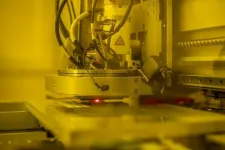
ELSE PRESS RELEASES FROM THIS DATE:
2021-06-10
RUDN and Shahid Beheshti University(SBU) chemist proposed an eco-friendly method for the synthesis of pyrrole and pyrazole derivatives with a wide range of applications in medicine: from antidepressants to anticancer. Moreover, the synthesized compounds possess interesting fluorescence features, and the bioactive scaffolds might attract great interest in the fields of clinical diagnostics and biomedical research in the future. The results are published in the Organic & Biomolecular Chemistry.
Heterocyclic compounds expose remarkable chemistry with significant applications in medicinal and organic chemistry, industry, and pharmaceutical. These compounds are widely ...
2021-06-10
Wine grape growers in California and elsewhere face increasing labor costs and severe labor shortages, making it difficult to manage and harvest a vineyard while maintaining profitability. Growers are increasingly turning to machines for pruning, canopy management and harvesting, but how well these practices are executed can substantially affect yield and quality. A new review by researchers at the University of California, Davis, published in the journal Catalyst, provides guidelines for growers to make the best use of machines.
"Wine grape laborers have been virtually nonexistent. People don't want to work in vineyards anymore because it's remote, tough work," said Kaan Kurtural, professor of viticulture and enology and extension ...
2021-06-10
BONN, 10 June - Unprecedented changes in climate and biodiversity, driven by human activities, have combined and increasingly threaten nature, human lives, livelihoods and well-being around the world. Biodiversity loss and climate change are both driven by human economic activities and mutually reinforce each other. Neither will be successfully resolved unless both are tackled together.
This is the message of a workshop report, published today by 50 of the world's leading biodiversity and climate experts.
The peer-reviewed workshop report is the product of a four-day virtual workshop between ...
2021-06-10
Kanazawa, Japan - Fungal diseases in cereal crops cause major economic losses and also threaten human and livestock health, because some fungi produce powerful toxins that might enter the food chain. Farmers use fungicides to control crop diseases, such as wheat head blight. Although agrochemicals are rigorously tested for safety, there can be concerns over chemical residues in food.
Now, researchers at Kanazawa University, in collaboration with colleagues at Ehime University and Nagoya University, have shown that the natural substance nicotinamide (NIM - a vitamin found in food and used as a dietary supplement) can help stimulate ...
2021-06-10
Curtin University researchers have helped uncover the four billion year old story of a lunar sample brought from the Moon to Earth, by the manned Apollo 17 mission more than 50 years ago.
The global research collaboration, involving scientists from the UK, Canada, Sweden and Australia, aimed to analyse the ancient rock sample through a modern lens to find out its age, which crater it came from and its geological trajectory.
That modern lens was provided, in part, by both Curtin's Geoscience Atom Probe Facility* and Space Science and Technology Centre* (SSTC) where the research team was ...
2021-06-10
With the onset of the 4th industrial revolution, artificial intelligence has recently been utilized in smartphone cameras, providing functions such as auto-focusing, face recognition, and 100x zoom, to dramatically improve our daily life. It has also been applied to research and development of new materials.
A joint research team from POSTECH and Korea Institute of Materials Science (KIMS) has applied deep learning to the scanning electron microscopy (SEM) system to develop a technique that can detect and improve the quality of SEM images without human oversight. The EMS is an essential material analysis equipment used for developing new materials. The findings from this research were recently published ...
2021-06-10
An inter-university research group has succeeded in constructing the gene expression network behind the vascular development process in plants. They achieved this by performing bioinformatics analysis using the 'VISUAL' (*1) tissue culture platform, which generates vascular stem cells (*2) from leaf cells. In this network, they also discovered a new BES/BZR transcription factor (*3), BEH3, which regulates vascular stem cells. In addition, they illuminated a novel vascular cell maintenance system whereby BEH3 competes with other transcription factors from the same BES/BZR family in order to stabilize vascular stem ...
2021-06-10
Cell viability require that a variety of functions at the cell membrane are maintained properly. P-type ATPases translocate substrates across the membrane, and they have evolved into different types taking care of specific substrates within a diverse range. Now, key structural aspects have been described on how two different types of P-type ATPases - a Ca2+ transporting Ca2+ -ATPase and a lipid transporting P4-ATPase - have adapted to different substrates and physical environments.
Many bacteria export intracellular calcium using active transporters homologous to the well-described ...
2021-06-10
Researchers from Tel Aviv University took part in a new international study proposing an amendment to the widely accepted theory on the extinction of animal species - by moving the focus from the animal's body size to its reproductive capacity. The researchers found gaps and incompatibilities between mammals and amphibians in the relation between body size and extinction risk: Whereas large mammals bear a smaller number of offspring per birth, leading to higher risk of extinction, larger amphibian females lay more eggs, reducing the threat to the species.
The researchers analyzed data from databases on both extinction risks and reproductive capacities of various species of amphibians (e.g., frogs and salamanders). Contributors to the ...
2021-06-10
How much do the effects of climate change contribute to extreme weather events? It's hard to say--the variables involved are plentiful, each event is unique, and we can only do so much to investigate what didn't happen. But a new paper from Lawrence Berkeley National Laboratory (Berkeley Lab) climate scientist Michael Wehner investigates the question for one particular element of one significant storm and makes the results available to those who lived through it.
In the paper, "Attributable human-induced changes in the magnitude of flooding in the Houston, Texas region during Hurricane Harvey," published May 19 in Climatic Change, Wehner and Christopher Sampson from Fathom Bristol used a hydraulic ...
LAST 30 PRESS RELEASES:
[Press-News.org] New way to 3D-print custom medical devices to boost performance and bacterial resistance

